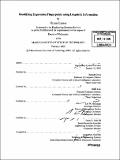| dc.contributor.advisor | Randall Davis and Boris Katz. | en_US |
| dc.contributor.author | Uzuner, Ozlem, 1975- | en_US |
| dc.contributor.other | Massachusetts Institute of Technology. Technology, Management, and Policy Program. | en_US |
| dc.date.accessioned | 2006-03-24T18:37:00Z | |
| dc.date.available | 2006-03-24T18:37:00Z | |
| dc.date.copyright | 2005 | en_US |
| dc.date.issued | 2005 | en_US |
| dc.identifier.uri | http://hdl.handle.net/1721.1/30286 | |
| dc.description | Thesis (Ph. D.)--Massachusetts Institute of Technology, Engineering Systems Division, Technology, Management, and Policy Program, 2005. | en_US |
| dc.description | Includes bibliographical references (leaves 181-192). | en_US |
| dc.description.abstract | This thesis presents a technology to complement taxation-based policy proposals aimed at addressing the digital copyright problem. The approach presented facilitates identification of intellectual property using expression fingerprints. Copyright law protects expression of content. Recognizing literary works for copyright protection requires identification of the expression of their content. The expression fingerprints described in this thesis use a novel set of linguistic features that capture both the content presented in documents and the manner of expression used in conveying this content. These fingerprints consist of both syntactic and semantic elements of language. Examples of the syntactic elements of expression include structures of embedding and embedded verb phrases. The semantic elements of expression consist of high-level, broad semantic categories. Syntactic and semantic elements of expression enable generation of models that correctly identify books and their paraphrases 82% of the time, providing a significant (approximately 18%) improvement over models that use tfidf-weighted keywords. The performance of models built with these features is also better than models created with standard features used in stylometry (e.g., function words), which yield an accuracy of 62%. In the non-digital world, copyright holders collect revenues by controlling distribution of their works. Current approaches to the digital copyright problem attempt to provide copyright holders with the same kind of control over distribution by employing Digital Rights Management (DRM) systems. | en_US |
| dc.description.abstract | (cont.) However, DRM systems also enable copyright holders to control and limit fair use, to inhibit others' speech, and to collect private information about individual users of digital works. Digital tracking technologies enable alternate solutions to the digital copyright problem; some of these solutions can protect creative incentives of copyright holders in the absence of control over distribution of works. Expression fingerprints facilitate digital tracking even when literary works are DRM- and watermark-free, and even when they are paraphrased. As such, they enable metering popularity of works and make practicable solutions that encourage large-scale dissemination and unrestricted use of digital works and that protect the revenues of copyright holders, for example through taxation-based revenue collection and distribution systems, without imposing limits on distribution. | en_US |
| dc.description.statementofresponsibility | by Özlem Uzuner. | en_US |
| dc.format.extent | 200 leaves | en_US |
| dc.format.extent | 11620170 bytes | |
| dc.format.extent | 11646101 bytes | |
| dc.format.mimetype | application/pdf | |
| dc.format.mimetype | application/pdf | |
| dc.language.iso | eng | en_US |
| dc.publisher | Massachusetts Institute of Technology | en_US |
| dc.rights | M.I.T. theses are protected by copyright. They may be viewed from this source for any purpose, but reproduction or distribution in any format is prohibited without written permission. See provided URL for inquiries about permission. | en_US |
| dc.rights.uri | http://dspace.mit.edu/handle/1721.1/7582 | |
| dc.subject | Technology, Management, and Policy Program. | en_US |
| dc.title | Identifying expression fingerprints using linguistic information | en_US |
| dc.type | Thesis | en_US |
| dc.description.degree | Ph.D. | en_US |
| dc.contributor.department | Massachusetts Institute of Technology. Engineering Systems Division | |
| dc.contributor.department | Technology and Policy Program | |
| dc.identifier.oclc | 60933836 | en_US |
